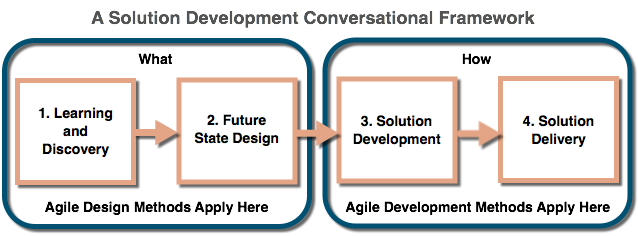|
Good design conversations don't happen by accident. They are started and sustained by capturing ideas in the moment and in a way that people can perceive. Here are some ideas to help you lead the design conversation and to capture the learning and discovery that occurs in a collaborative meeting. The big takeaways:
Resources referenced:
1 Comment
As a solution designer or marketer, tuning into the context and experience of a person in a predicament is fundamental. There is no side-stepping around these questions:
A cogent, well-crafted problem statement answers these questions and provides clarity of context to solution designers and product marketers. Why a Problem Statement Is ImportantA problem involves a person in the context of a specific predicament. The problem is the raison d'être for any solution under consideration and, by extension, the gold for which the solution designer is mining. A person experiencing a problem expresses it through emotion. Describing the circumstances causing their feelings in their words, however strong or subtle, provides a foundation of empathy to design an ideal solution. It is essential to recognize the emotion because it produces the personal resonance of the problem context, effectively influencing the thinking about the solution design. A problem statement depicts the moment of opportunity when a transformational solution would make all the difference in a person's quality of life. Problems Lead to SolutionsFrom a marketing perspective, borrowing a concept from Pragmatic Institute, a “market” is a group of people who share the same problem. Therefore, observing, understanding, and clearly describing a problem with resonance is the cornerstone of any solution, making a highly refined problem statement, or set of statements, all the more valuable. Who needs or uses problem statements?
How To Create a Problem StatementHere is an effective way to create a statement that expresses an understanding of the context and the problem so that it informs and influences solution designers and architects. A problem statement is a sentence or a small set of sentences that includes these descriptive elements:
Actual Statements and Mad-Lib Styled Templates You may be fortunate and can describe the problem statement by simply transcribing what you have observed people say in the context of experiencing an issue. That's a preferable way in which to produce a problem statement. But, if you don't have that form of recall handy or need some help constructing a statement, then some fill-in-the-blank templates help demonstrate what this looks like. To that end, here are some Mad-Lib-styled templates:
Examples Here are two examples of problems statements based on conversations I've had and observations I've had in just the past day:
Best Practices and Pitfalls to Avoid
How To Create an Ideal Solution StatementA common pitfall when designing a solution is rushing too quickly into describing how providers should implement the solution. A way to avoid that pitfall is to describe the solution's effect on the person instead of explaining how to solve the problem. An ideal solution statement avoids this pitfall by informing and influencing solution designers and architects on what is needed while respecting their role in designing how to solve the solution. An ideal solution statement is a sentence or two that:
Examples Here are ideal solution statements based on the aforementioned problem statements:
Best Practices to Use and Pitfalls to Avoid
Practical ApplicationAn ideal solution statement can easily feed into agile development practices in the form of a user story. Developers use user stories in agile solution development to create a backlog for product development. The user story that is widely practiced in agile communities reads like this:
Here is how our example ideal solution statements can be transformed into a user story that can be used by an agile development team:
In addition to user stories, the problem statement described herein offers a richer contextual insight for solution designers to understand how their envisioned solution user experiences the problem. Combining a problem statement with the ideal solution statement increases the potential for designers and architects to empathize with the problem. This insight improves their ability to design a solution that resonates with the intended user. It also enhances the ability of a product manager to strategically position the solution in the market, communicating with resonance through marketing channels and sales efforts. Want More?Subscribe to my free blog updates to receive content that vividly describes the techniques and leadership skills that embody the practice of agile design methods. The blog contains not only my ideas on the topic but the insight of others who actively work and thrive wholeheartedly in the realms of collaborative creativity and solution design.
It passes so quickly that you’ll miss the opportunity if you’re not paying attention. It’s that initial moment in the process when a person introduces themselves, shares who they are and what and their organization does. That moment is rich with potential and it goes by quickly. What To Listen ForBe prepared for the moment in advance by having your co-facilitor serve as a scribe, recording the person’s name on a single sheet of paper or in a note-taking tool like Evernote. Then your scribe should listen for and record any of the following items that the person mentions: Nouns
Verbs
Pain Points / Opportunities Example“I’m Juanita and I work for the Finance Department. We use Dynamics to produce final paychecks when an employee departs and work with Legal and Procurement and Travel to ensure that any garnishments are taken out prior to their final paycheck and that any reimbursements for travel expenses are also included in their last paycheck. We also produce W-2s for departed employees at the end of the year. It’s a challenge and a very manual process to get all of this done thoroughly in a short timeframe, particularly when an employee departure occurs quickly.” Nouns
Verbs
Pain Points / Opportunities
What To Do With ThisHold on to them. They will come in handy in the structured conversation that will unfold in the hours and days that lie ahead. Nearly every one of these nouns are added to a Glossary. Many of them will eventually be placed around a Circle of Interaction (COIN) diagram that clearly summarizes the process, collaborators and deliverables on a single page. Why This MattersWhen it comes to facilitating and producing a clear understanding of a domain under discussion, if it hasn’t been written then it hasn’t been said. To say it another way, if it’s been said, but hasn’t been recorded, then it will not have the potential to be added to design documentation.
Being intentional to listen for and record things that a stakeholder mentions serves the stakeholder and the conversational process well. It keeps things agile. It serves the stakeholder well by respecting their contribution to the conversation. It serves the process by maintaining velocity, by creating a corporate memory of what was mentioned and by listening for those things which will be part of the future-state design documentation. Want More?Subscribe to my free blog updates to receive content that vividly describes the techniques and leadership skills that embody the practice of agile design methods. The blog contains not only my ideas on the topic, but the insight of others who actively work and thrive wholeheartedly in the realms of collaborative creativity.
Join us. Agile design methods are powerfully simple techniques and leadership skills that make process design conversations flow with better collaboration and results. When considering how to get from understanding a problem to designing and delivering a solution, the process is a predictable set of conversations that inform every step along the way from ideation to delivery. Getting "from-concept-to-market" faster and more effectively yields competitive advantage as well as a solution more likely to resonate with the people who will ultimately buy or use it. The concepts described herein apply whether your field of endeavor is operational excellence or product development. As an organizational leader facilitating efforts to improve a process or product manager engaging your design team, you face predictable challenges when moving from some vague notion of a concept to actually designing the solution. Here are some aspects that affect your future state design process:
A Solution-Oriented Conversational Framework
Early conversations focus on Why and What:
Latter conversations focus on How:
This approach lends itself to introducing the right conversation at the right time. Conversation #1: Learning and Discovery The scope of this conversation pertains to the understanding of the problem. This conversation is in scope of agile design methods. Allow the voice of the people who are experiencing the problem(s) to inform this conversation. Listen and learn and document that learning to describe what each problem looks like and summarize them in problem statements in addition to statements of what is working well. Document this learning and discovery conversation to inform the future state design conversation. Decide whether or not to proceed to a future state design conversation. Conversation #2: Future State Design The scope of this conversation pertains to the describing the ideal solution. This conversation is in scope of agile design methods. Allow a dedicated and accountable group of contributors to inform a conversation around describing "what" the ideal solution looks without describing "how" the solution will be implemented. The descriptive language is free from any implementation jargon and focuses on delivering a clear description of the envisioned solution that may include process definitions, key solution deliverables, user experience criteria, risks, issues and opportunities. Document this future state design conversation to inform the solution development conversation. Decide whether or not to continue to a solution development conversation. Conversation #3: Solution Development The scope of this conversation pertains to designing and developing the solution. This conversation is out of scope of agile design methods. Allow a dedicated and accountable group of designers and architects to inform a conversation that describes "how" the ideal solution will be implemented. The descriptive language is rich in implementation detail. It may provide design alternatives that provide varying degrees of cost, risk, time, return on investment, etc. Decisions are made regarding design alternatives and leading to the actual development of a solution. Document this solutions development to inform the solution delivery conversation. This conversation is out of scope of agile design methods. Conversation #4: Solution Delivery The scope of this conversation pertains to the delivery and support of the solution. This conversation is out of scope of agile design methods. Allow a dedicated and accountable group to inform a conversation that oversees the delivery of the solution. This includes launching and promoting the solution as well as supporting it and providing user experience feedback to inform solution improvement efforts. Agile Design Methods Describe What Not HowAgile design methods are those techniques and leadership skills that enable a future state design process characterized by high velocity, collaborative engagement and clarity of ideation. The resulting design is typically produced at a lower cost than traditional methods with a high degree of precision and improved stakeholder engagement and satisfaction. The outputs of these conversations intentionally stop short of designing the implementation, They describe what the problems are and what the ideal solution qualities look like. This informs solutions architects and designers who are responsible for determining how to design the solution and the production/development teams that will deliver it. Agile Design Methods: The What Perspective Agile design methods, as quickly as practically possible, describe what is envisioned to be an ideal process or solution. They produce ideation deliverables that describe what the problems are and what the ideal solution qualities look like. Exercising this type of "Design the What" discipline respects a separation of concerns between the market problem definition and the solution design definition. It informs the solution designers and architects who are responsible to "Design the How" of the solution under discussion. At the time of this writing, the phrase "agile design methods" is not widely used or understood. Agile Development Methods: The How Perspective In contrast, agile development methods, as quickly as practically possible, define how to architect the solution and then proceed in building and delivering that solution. They produce deliverables that describe how the solution is to be implemented and they produce the actual solution. At the time of this writing, the phrase "agile software development" is commonplace and is routinely associated with the word "agile". Agile Design Methods: Subscribe for "How To"The purpose of this primer has been to establish a foundation of a conversational framework that provides context as to where agile design methods fit in an overall solution development life cycle.
It sets the stage for further elaboration on topics related to agile design methods, collaborative creativity, product development and user experience. - Chuck Subscribe to my free blog updates to receive content that vividly describes the techniques and leadership skills that embody the practice of agile design methods. The blog contains not only my ideas on the topic, but the insight of others who actively work and thrive wholeheartedly in the realms of collaborative creativity. I look forward to you joining us. It's going to be quite a journey. |
Learn the Art of
Successful Agile Design
About Chuck Boudreau(boo'-dro) - I help people design solutions collaboratively using agile design methods. I have 30+ years of experience in designing software solutions and business processes, leading cross-functional process improvement teams as a business analyst, and helping product managers define and position products using Pragmatic Marketing. I am passionate about user experience design, dog training, beating drums in musical ensembles and collaboratively creating solutions with people.
Archives
April 2018
Categories
All
|
||||||||||||





 RSS Feed
RSS Feed